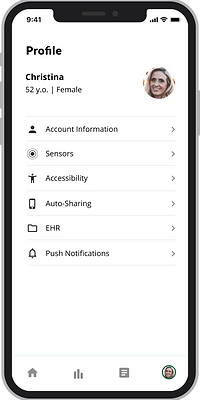Task
Design a futuristic human-machine system, considering the challenges and aspirations of the modern human.
Motivation
Our group was particularly motivated to center our project around health & wellness. We wanted to consider the most widespread health issues and devise a way to improve the overall wellness of human beings in their everyday lives.
Health Monitoring System
After brainstorming a list of the most pervasive health & wellness issues as well as a variety of potential solutions, we collectively decided that we wanted to design some sort of health monitoring system. Our rationale was that understanding your current health should be the first step in trying to live a healthier life. We considered the state of current health monitoring systems like the Apple Watch and the Health app. Recognizing some of the drawbacks of these current technologies, we wanted to make sure the system we designed was inconspicuous, automatic, and comprehensive.
Background Research
Our background research focused on determining what health metric collection methods are out there and how they could be integrated into/onto the home/human body. Many important metrics are collected through blood tests. We imagine, in the future, our system might employ some sort of implant to constantly conduct tests on an individual's blood. Or maybe more feasible: some sort of at-home, reusable blood tester that innocuously takes blood samples and uploads results to the system database.
We found that many health metrics, however, can also be collected through noninvasive means: through the use of AI, machine learning, and various biomarkers. There are countless sources for these biomarkers, including voice, eyes, skin, saliva, urine, stool, and hair. Algorithms have been developed (and continue to be developed) to detect health metrics/information like heart rate, blood pressure, and risk of diabetes and cardiovascular disease (and many more) based on the biomarkers picked up by sensors. We decided to base our project around this idea that sensors around the home could collect biometric data on users and, with the use of AI, provide important health information.
User Personas

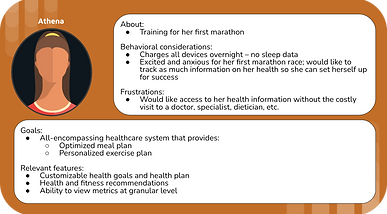
Since striving for good health is such a universal goal, we knew our product would require consideration of all different types of users. Consequently, we created three different personas in hopes of capturing the varying characteristics that we might see in our users (two examples shown above). These personas differed on a number of dimensions, including health goals, health status, and age. Consideration of these personas helped guide our design decisions. For example, thinking about Reggie's old age and frequent illnesses led us to understand the importance of notifications and notification sharing. Given Reggie's vulnerable state, he wants to be notified of even the slightest changes in his health, and his family wants to know about any serious health developments ASAP.
Note: Given the timeline of our project, we were unable to conduct user research to support our persona development. However, we still feel that creating personas helped us to empathize with potential users and cater the product toward their imagined needs.
Task Analysis
In addition to creating personas, we also used task analysis to help guide us toward our solution. We considered the steps involved in the task of being healthy (prior to the development of our system)
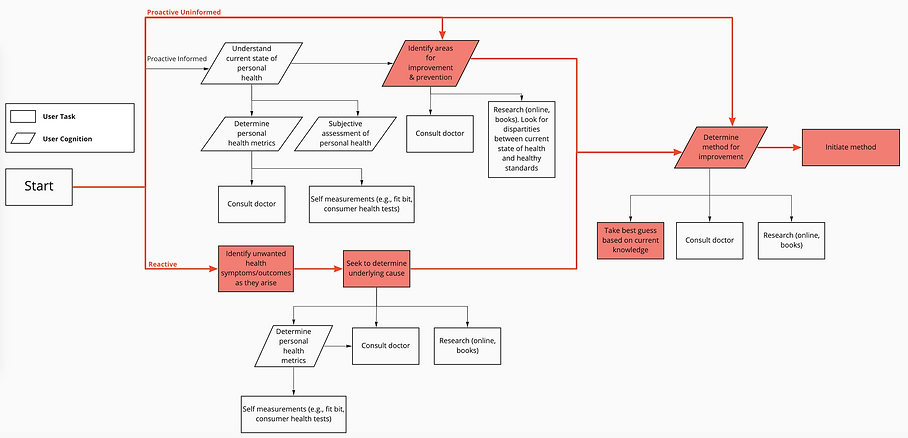
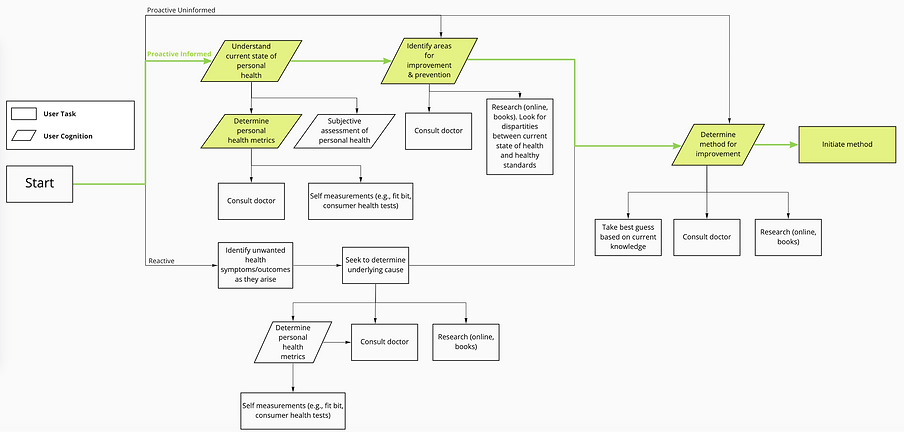
This task analysis reveals three primary paths that people could take to achieve health. We referred to these paths as “Proactive uninformed,” “Proactive informed,” and “Reactive.” We determined that while the “Proactive uninformed” and “Reactive” paths were not the ideal paths to achieve health, these are the paths that most people tend to take. The “Proactive informed” path is ideal because it involves acting before something bad happens (sometimes before it becomes too late to intervene) and making educated decisions (thereby removing the guesswork). However, significant roadblocks stand in this path; understanding the current state of your personal health and determining personal health metrics at a comprehensive level is very challenging and tedious for most people. Through our system, we hope to make the “Proactive informed” path more feasible, namely by providing a way for people to understand the state of their personal health by looking at important personal health metrics.
Information Architecture
After determining the features and information we wanted to include in our product, we organized the information architecture by creating the following product flow:
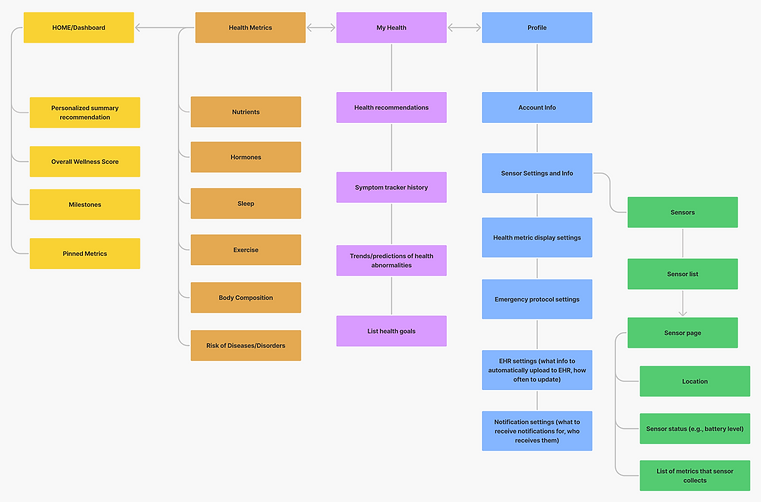
Our Solution
Omnisense is a futuristic IoT (internent of things) network of connected sensors around the home and on/in the body that passively collect health data from the user. Through machine learning and AI, the system uses the data collected from the sensors to provide the user with comprehensive health information, including an easily digestible display of health metrics and tailored recommendations for how the user can improve their health. We have designed an app, but we envision that users would be able to interface with our system in many other ways, like voice, displays on mirrors, and even holograms.
Main Features
Health Metrics


Users can view their overall health score, as well as scores for different health categories and individual metrics. User metrics are compared with healthy standards and the color surrounding each score lets the user know where they stand.
Personalized User Goals and Recommendations
Users can input health and fitness goals into the system and receive personalized recommendations based on their goals. Users can also receive general recommendations based on health metrics, with recommendations color-coded by urgency levels.
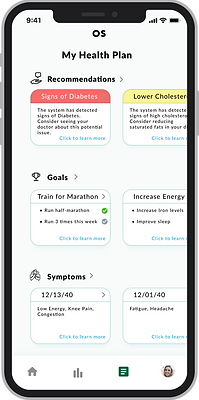
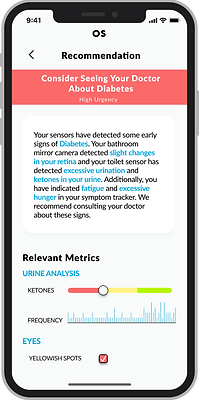
Symptom Tracker

While the heart of our product is the passive nature of its data collection, we still find it important that users are able to manually input data into the system. Thus, we included a symptom tracker, where users can log and view the history of their symptoms.
Data Sharing + Notifications
Health information can be useful for people other than the primary user, including doctors and family members. However, health information can also be sensitive. With our system, the user will have the power to share as much information as they want and even upload to their EHR. Additionally, users can customize what information they want to be notified about.
